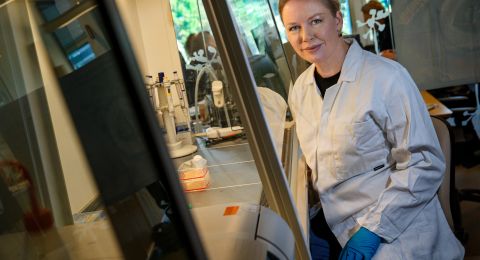Membrane proteins are the primary target of many drugs. These proteins play a key role in regulating the body’s functions and communication between cells. Wallenberg Scholar Erik Lindahl is developing new methods to study these proteins in situ in tissue.
Erik Lindahl
Professor of Biophysics
Wallenberg Scholar
Institution:
Stockholm University
Research field:
Structure and function of ligand-gated ion channels, especially in the human nervous system
Membrane proteins occur in and on cell membranes. Lindahl is especially interested in membrane proteins known as ion channels, which can be likened to miniature doors that allow charged particles in and out of cells. Opening and closing these ‘doors’ control everything from cells’ temperature to electrical charge. The channels are also affected by other molecules present in membranes. This results in a complex interaction which means that the same type of ion channel can have different functions depending on where it is found in the body.
“We want to improve understanding of the function of these proteins, so it’s not enough to study them in isolated form. We need to examine them in situ in cell membranes and tissue. The problem is that there aren’t any methods to do this yet,” says Lindahl, professor at Stockholm University.
A long-term passion
Lindahl’s fascination for ion channels started more than twenty years ago. As a young graduate student at Stanford University, he was asked if he could develop a method to model how ion channels moved.
“My initial reaction was that it was impossible. But then I thought why not spend an afternoon on it – just to say that I’d tried.”
That afternoon was the start of a lengthy research career that also included development of the GROMACS computer programs and parts of RELION, which are now used by researchers worldwide on a daily basis.
“As soon as someone develops a new protein structure today, they want to run a simulation of how it moves. And to do that, the vast majority use the software that we developed.”
The development of new calculation-based modeling techniques has become something of a common theme throughout his career, Lindahl says.
“My colleagues can make computers do tricks today in ways that I didn’t think was possible just ten years ago. But what really drives us is understanding how signaling in the nervous system works.”
Combining methods
A couple of floors below Lindahl’s office in SciLifeLab are some of the keys to a better understanding of the nervous system’s signaling. At the SciLifeLab research center, researchers from four universities work side-by-side, surrounded by a unique technical infrastructure, including three cryo-electron microscopes that enable far more detailed imaging of protein structures than has previously been possible.
“Cryo-electron microscopy gives us a window into protein structures, which makes it possible to see them in detail. The problem is that the picture we see is so incredibly ‘noisy’.”
Lindahl’s research group is developing new calculation methods to obtain more information from these images. These methods make it possible to extract significantly more information from the noise. When they are combined using various AI methods, the researchers are also able to make predictions about proteins’ structure and movement in membranes.
Sometimes it feels like a massive blank page with no rules. We want to explain the rules and predict how membrane proteins react in different situations.
The development of this approach involves tomography (similar to X-ray-tomography used in hospitals), to recreate proteins’ 3D structures. The method is based on taking millions of pictures of the sample from different angles and then combining them into a three-dimensional shape in the computer.
As we follow Lindahl down the stairs to the microscope lab, he stresses how little he really knows about the technical details of microscopes. To take things forward, a suite of different skills is required.
“We’ve been fortunate to recruit incredibly talented postdocs. That’s one of the best things about SciLifeLab: we attract global stars at a young age.”
This basic research is pushing the boundaries of what is known about membrane proteins. With a deeper understanding of the complex interplay that governs them, it becomes possible to develop new and better drugs.
“Naturally, I hope that our work contributes to the development of more accurate treatment methods. But what really fascinates me the most is the huge diversity of biological molecular mechanisms.”
The importance of teaching
Lindahl has been asked for his autograph at international conferences – although more for his impact as a teacher than his research breakthroughs. When the pandemic closed the doors of the college, he developed a digital course that has today attracted more than one million views.
“Moving into digital teaching was something I’d thought about for several years. When the pandemic hit, I thought it was now or never. So, I bought equipment and set up camp in a conference room for four weeks to make the recordings.”
After many late nights, he had made approximately 400 episodes that he posted on YouTube.
“Today, I start each course by asking students to watch the films first. Then we meet to discuss the content.”
As a researcher, it can be easy to forget the importance of teaching, he says.
“I am of course immensely proud of all the scientific articles that we publish. But my contribution to students’ knowledge probably means more to humanity than my research – simply because there are so many more of them who will have even better ideas in the future,” says Lindahl.
Text Magnus Trogen Pahlén
Photo Magnus Bergström
Translation Nick Chipperfield






